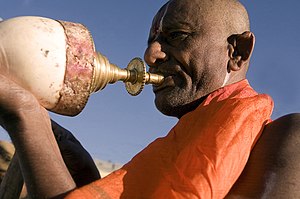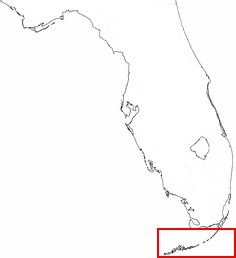Conch (/ˈkÉ'Å‹k/ or sometimes /ˈkÉ'ntʃ/) is a common name that is applied to a number of different medium to large-sized sea snails or their shells. The term generally applies to large sea snails whose shell has a high spire and a noticeable siphonal canal (in other words, the shell comes to a point at both ends).
True conchs are marine gastropod molluscs in the family Strombidae, specifically in the genus Strombus and other closely related genera such as Eustrombus.
Many species also are often called "conch", but are not in the family Strombidae, including Melongena species (family Melongenidae), and the horse conch Pleuroploca gigantea (family Fasciolariidae). They also include the sacred chank or more correctly shankha shell (Turbinella pyrum) and other Turbinella species in the family Turbinellidae.
Etymology
.jpg/220px-Sea_shell_(Trinidad_%26_Tobago_2009).jpg)
The original word is from Sanskrit "shankha". When the Portuguese first encountered India in the Bengal region and the western coast, the local dialects had an "o" pronunciation for the middle "a" and a softening of the initial "sh" and final "kh". The word was pronounced locally as "sonka" which in Portuguese was transliterated as "çoncha" (with very similar pronunciation as "sonka") and alternatively without the final "a". The English word is a spelling pronunciation of the Portuguese word.
Food

The meat of conchs is eaten raw in salads, or cooked, as in fritters, chowders, gumbos, and burgers. All parts of the conch meat are edible. Some people, however, find only the white meat appetizing.
In The Bahamas, conch is typically served in the form of fritters or as salads. Conch is considered to be the country's main dish.
In East Asian cuisines, this seafood is often cut into thin slices and then steamed or stir-fried.
In the West Indies (and Jamaica in particular), local people eat conch in soups, stews and curries. Restaurants all over the islands serve this particular meat.
In the The Turks and Caicos Islands, the Annual Conch Festival is held in November each year, located at the Three Queen's Bar/Restautant in Blue Hills. Local restaurateurs compete for the best and most original conch dishes, that are then judged by international chefs. Free sampling of the dishes follows the judging; along with those festivities, other competitions, events, and music performances occur well into the evening.
In the island of Grenada, Dominican Republic & Haiti, conch is commonly eaten in curries or in a spicy soup. It is locally referred to as lambi.
In Puerto Rico, conch is served as a ceviche, often called ensalada de carrucho (conch salad), consisting of raw conch marinated in lime juice, olive oil, vinegar, garlic, green peppers, and onions.
In Panama, conch is known as cambombia and is often served as a ceviche known as ceviche de cambombia consisting of raw conch marinated in lime juice, chopped onions, finely chopped habaneros, and often vinegar.
Musical instruments

Conch shells can be used as wind instruments. They are prepared by cutting a hole in the spire of the shell near the apex, and then blowing into the shell as if it were a trumpet, as in blowing horn. Sometimes a mouthpiece is used, but some shell trumpets are blown without one.
Various species of large marine gastropod shells can be turned into "blowing shells", but some of the best-known species used are the sacred chank or shankha Turbinella pyrum, the Triton's trumpet Charonia tritonis, and the queen conch Strombus gigas.
Pearls

Many different kinds of molluscs can produce pearls. Pearls from the queen conch, S. gigas, are rare and have been collectors' items since Victorian times. Conch pearls occur in a range of hues, including white, brown and orange, with many intermediate shades, but pink is the colour most associated with the conch pearl, such that these pearls are sometimes referred to simply as "pink pearls". In some gemological texts, non-nacreous gastropod pearls used to be referred to as "calcareous concretions" because they were "porcellaneous" (shiny and ceramic-like in appearance), rather than "nacreous" (with a pearly lustre), sometimes known as "orient". The GIA and CIBJO now simply use the term "pearl" â€" or, where appropriate, the more descriptive term "non-nacreous pearl" â€" when referring to such items, and under Federal Trade Commission rules, various mollusc pearls may be referred to as "pearls" without qualification.
Although non-nacreous, the surface of fine conch pearls has a unique and attractive appearance of its own. The microstructure of conch pearls comprises partly aligned bundles of microcrystalline fibres that create a shimmering, slightly iridescent effect known as "flame structure". The effect is a form of chatoyancy, caused by the interaction of light rays with the microcrystals in the pearl's surface, and it somewhat resembles Moiré silk.
Other uses
- Conch shells are sometimes used as decoration, as decorative planters, and in cameo making.
- In classic Maya art, conchs are shown being used in many ways, including as paint and ink holders for elite scribes, as bugles or trumpets, and as hand weapons (held by combatants by inserting their hands in the aperture).
- Some American Aboriginals used cylindrical conch columella beads as part of breastplates and other personal adornment.
- In some Afro-Caribbean and African-American cemeteries, conch shells are placed on graves.
- In some Caribbean countries such as Jamaica and the Bahamas, cleaned queen conch shells, or polished fragments, are sold, mainly to tourists, as souvenirs or in jewelry. Responding to a 2003 recommendation from CITES, some countries in the Caribbean have banned the export of queen conch shells. CITES has also asked all countries to ban import of these shells from countries that are not complying with CITES recommendations for managing the fishery. Queen conch fisheries have been closed in several countries. Conch shells or fragments taken home by tourists from noncomplying countries may be confiscated on return to the tourist's home country while clearing customs. In the UK, conch shells are the ninth most-seized import.
- Conch shells are occasionally used as a building material, either in place of bricks, or as bulk for landfill.
- In Grenada, fishermen use the conch shell as a trumpet to announce to the community that fish is available for sale. Conchs are used at Carnival times in the Jouvert Jump where Diab Diab (Jab Jab) blow conch shells as part of the festivities. Especially in Guadeloupe, it is not uncommon to hear conch shells being blown near ports at dawn and during Carnival times, too. Many bands are making the conch shell a main instrument.
- In the Bahamas, broken or up-turned conch shells are imbedded into the tops of outdoor walls in an effort to maintain home security; the broken or up-turned shells are sharp enough to cut any intruder who attempts to jump or crawl over the wall.
- They can also be used as a token to determine whose turn it is to make the tea. The tea maker symbolically hands over the conch to the person who will be the next to put the kettle on.
Religion

Hinduism
A shankha shell (the shell of a Turbinella pyrum, a species in the gastropod family Turbinellidae) is often referred to in the West as a conch shell, or a chank shell. This shell is used as an important ritual object in Hinduism. The shell is used as a ceremonial trumpet, as part of religious practices, for example puja. The chank trumpet is sounded during worship at specific points, accompanied by ceremonial bells and singing. As it is an auspicious instrument, it is often played in a Lakshmi puja in temple or at home.
In the story of Dhruva, the divine conch plays a special part. The warriors of ancient India blew conch shells to announce battle, as is described in the beginning of the war of Kurukshetra, in the Mahabharata, the famous Hindu epic.
The god of preservation, Vishnu, is said to hold a special conch, Panchajanya, that represents life, as it has come out of life-giving waters.
Also, the sound of the conch is believed to drive away the evil spirits. The blowing of the conch or "the shankha" needs a tremendous power and respiratory capacity. Hence, blowing it daily helps keep the lungs healthy.
Buddhism
Buddhism has also incorporated the conch shell, Turbinella pyrum, as one of the Eight Auspicious Symbols.
Ancient Peru
The Moche people of ancient Peru worshipped the sea and often depicted conch shells in their art.
Literature and the oral tradition

William Golding's Lord of the Flies features frequent references to "the conch". In the book, the conch is used as a trumpet to call everyone together and held by whoever is speaking at meetings, symbolically representing democracy and order. The conch is seen as a delicate and beautiful object to represent this concept, although its fragility is shown when it "exploded into a thousand white fragments and ceased to exist."
The famous Old English riddle Ic wæs be Sonde describes a conch: "I was by sound, near seawall, at ocean-stream; I dwelt alone in my first resting place. ... Little did I know that I, ere or since, ever should speak mouthless over mead-benches." Another meaning given to this riddle ‘Ic wæs be Sonde’ is that the sound of the conch corresponds to spiritualised sound as heard in higher realms. In the Hindu tradition, the conch shell is used in ceremony as the sound it makes is said to correspond with higher frequency universal sounds associated with music of the spheres.
In Prakrit poetry, the conch (शंख; shankha) has an erotic connotation:
-
- Look,
-
- a still, quiet crane
- shines on a lotus leaf
- like a conch shell lying
- on a flawless emerald plate.
-
- Look,
(HÄla's gÄhÄ sattasaÄ« 1.4; tr. M. Selby)
Ostional, a pueblo in the municipality of San Juan del Sur in the Rivas Department of the southwest region of Nicaragua, by accounts of multiple testimonials in the local region, was founded by their ancestors because of an abundant conch population at the sea shore. Subsequently, the tribe used conch shells in many rituals and customs. In 2008, witnesses at local archaeological digs reported conch shells were found in the graves of some indigenous people in their recently rediscovered cemetery grounds. Some still maintained jade stones, implying the significance of conch shells within their tribal society.
See also
- Seashell
- Seashell resonance
References

External links

-  Chisholm, Hugh, ed. (1911). "Conch". Encyclopædia Britannica (11th ed.). Cambridge University Press.Â
